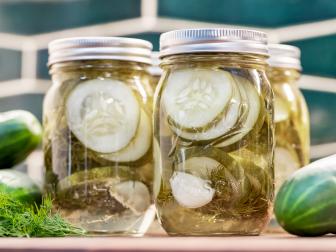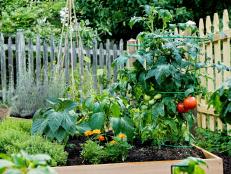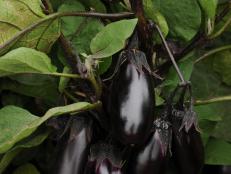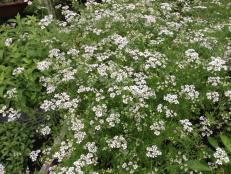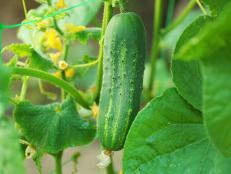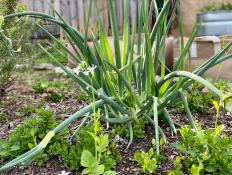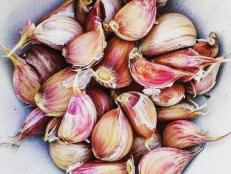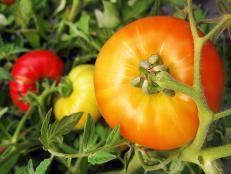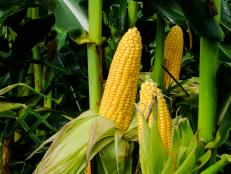Best Companion Plants for Cucumbers
Discover companion planting techniques to boost your crop of cucumbers and avoid common pests like cucumber beetles and squash bugs.

It’s a snap to grow your own crisp, refreshing cucumbers in a vegetable garden or in containers. These sun-loving summer annuals are prolific growers when they’re happy, but they are susceptible to pest pressures that can limit their growth. Experiment with companion planting to keep your cucumbers healthy and productive.

Shain Rievley
Grow cucumbers on a trellis to keep them off the ground and make more space in a small garden.
What is Companion Planting?
It’s natural for plants to experience some level of pest damage. Plants are resilient — they can usually tolerate pests and diseases pretty well. But when we grow the same handful of crops in the same spot year after year, populations of plant-eating insects and disease-causing fungi and bacteria build to levels that can impair plant health and diminish the harvest.
Companion planting is all about diversity. Begin by simply opening up some garden real estate to new species of vegetables, herbs, and flowers to bump up plant diversity. When you add plants that are less susceptible to the pests and diseases that affect vegetable crops, you’re helping to protect those precious vegetables, often by camouflaging them from pests through foliage or fragrance.
Not all companion plants are equal, though — depending on which companion you choose, the companion plant can help out your cucumber crop in a number of different ways.
- Flowering insectary plants attract beneficial insects — like pollinators and pest predators — with energy-rich pollen and nectar. Flowering vegetables like cucumbers depend on visits from pollinators in order to produce fruit. Cucumbers are botanical fruits that often have distinct male and female flowers. Pollinating insects must bring pollen from the male flowers to the female flowers for cucumber fruits to develop.
- Banker plants provide habitat and food for predators of garden pests. Living mulches and cover crops are often used as banker plants, and they are also valued for improving soil quality by adding organic matter, enhancing nutrient availability, and feeding beneficial bacteria, fungi, and other soil-dwelling organisms.
- Repellent plants produce chemical compounds that certain cucumber pests dislike. Aromatic herbs, flowers, and vegetables are often used as repellent plants.
- Trap crops are attractive to pests. In fact, the species used are more appetizing to pests than the desired crop. Trap crops for mobile insects should be planted far enough away that they do not inadvertently become a source of pests.
How to Grow Cucumbers
Get advice for planting, growing and harvesting cucumbers, including suggestions for types and varieties to grow, companion plants, plus tips for solving common cucumber problems.
Cucumber Companions
To Improve the Harvest
- Partner annual flowers and herbs like cosmos, zinnia, borage, and basil with cucumbers to attract pollinators to the vegetable garden.
- Grow green garlic (Allium sativum) with cucumbers to increase organic matter in the soil and make important nutrients like nitrogen, phosphorus, potassium, calcium, and manganese more available. Cucumbers that closely grow with green garlic do a better job absorbing these nutrients than cucumbers grown on their own.
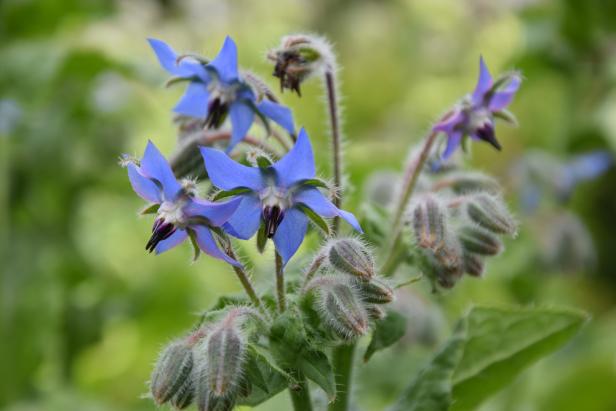
Shutterstock/rdp15
Borage is a beautiful flowering herb that attracts pollinators and other beneficial insects. The leaves and flowers are also edible — the flavoe is actually very reminiscent of cucumber. Borage readily self-sows in the garden but, since it's so pretty and so helpful, most gardeners don't mind.
To Control Pests and Diseases
- Grow cucumbers with Welsh onions (Allium fistulosum) to limit root knot nematode damage. Welsh onion roots exude chemical substances that reduce the number of nematode eggs that hatch.
- Grow radish, nasturtium, and tansy to repel cucumber beetles. Nasturtium can also be grown as a trap crop for squash bugs.
- Companion plant with buckwheat or cowpeas to attract predators of cucumber beetles such as tachinid and syrphid flies, parasitic wasps, and Pennsylvania leatherwing.
- If you have struggled with striped cucumber beetles in the past, grow a trap crop of ‘Blue Hubbard’ squash, ‘Waltham’ butternut squash, or ‘Burgess’ buttercup squash to lure the beetles away from cucumber plants. If possible, combine ‘Blue Hubbard’ with ‘Waltham’, as they have slightly different flowering periods that will attract cucumber beetles over a longer period of time. If you are growing a large plot of susceptible vegetables, grow these trap crops several feet away from vulnerable plants, spaced around the perimeter to intercept cucumber beetles. Try to collect and remove pests from the trap crops to prevent them from moving to your cucumber crop.
- Grow a cover crop of winter wheat the season before starting cucumbers to build beneficial fungal and bacteria communities in the soil, diminish soil-borne disease populations, and improve cucumber seedling growth.
To Attract Predators of Pests
- Grow a living mulch of oats with vetch or white clover to provide habitat for cucumber beetle predators. Keep the living mulch trimmed back to prevent it from competing with cucumbers for sunlight, water, and nutrients.
- A living mulch of red clover will provide habitat for predators of cucumber pests, including minute pirate bugs, ladybugs, and big-eyed bugs.
Bad Neighbors for Cucumbers
Cucumbers have allelopathic properties that inhibit other plants’ ability to flourish — especially seedlings (regardless of the species) and cucurbit neighbors (like squash, pumpkin, and melon) that are growing too closely. This mechanism helps cucumbers flourish by limiting competition from other species of plants but makes them bad neighbors for new successions of crops in the vegetable garden.
Use cucumbers’ allelopathy to your advantage by growing as a living mulch under large, established plants like okra, tomatoes, and corn. As the cucumber vines spread out over the soil, they will limit the growth of weeds.
How to Pickle Cucumbers
Making pickles is a great first-time canning project; it's easy, safe and odds are good that you already have everything you need to get started right at home.
Tips for Growing Cucumbers
There is a cucumber variety for every garden, from compact bush types for window boxes and containers to meandering vines for trellises and groundcovers. Many varieties of squat, thin-skinned pickling cucumbers as well as longer, thicker skinned slicing cucumbers are available in both bush and vining growth habits. Choose the combination of fruit type and vine type that works for you.
Cucumbers need a sunny spot with moist, well-drained soil that is rich in organic matter. Plant cucumber seeds directly in the garden once soil temperatures are reliably more than 60 degrees Fahrenheit and all danger of frost has passed. Water consistently and fertilize regularly to maximize growth. Fruit should begin to form within 50-70 days after planting, depending on the variety and environmental conditions. Pick fruit regularly to keep plants productive.
Tips for Crop Rotation
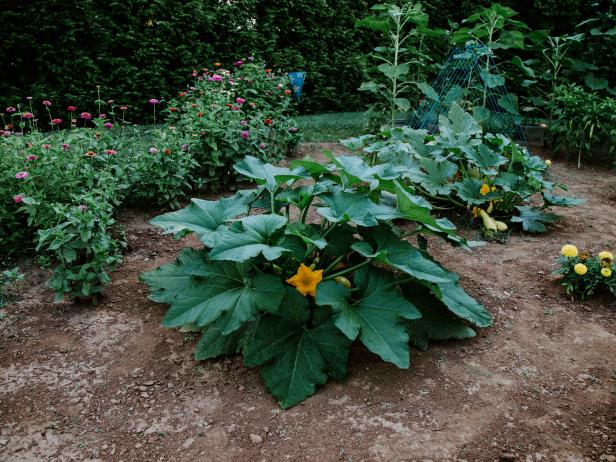
Shain Rievley
Grow cucumbers, squash, and melons together and rotate their placement in the garden from year to year.
Cucumbers and their close relatives squash, pumpkins, and melons are susceptible to many of the same pests and diseases. In large gardens with plenty of space for rambling vines, group cucurbits together and rotate where they are grown each season. However, this may not be practical for smaller gardens.
To maximize space, cucurbits could be trellised or used as a living mulch around larger, more established plants (see “Bad Neighbors” above). Keep track of where cucumbers and their relatives have been cultivated in previous seasons and try to provide a season or more of a break between cucurbits in the crop rotation. If you notice pests or disease pressures increase, take these crops out of the rotation for a longer period.







